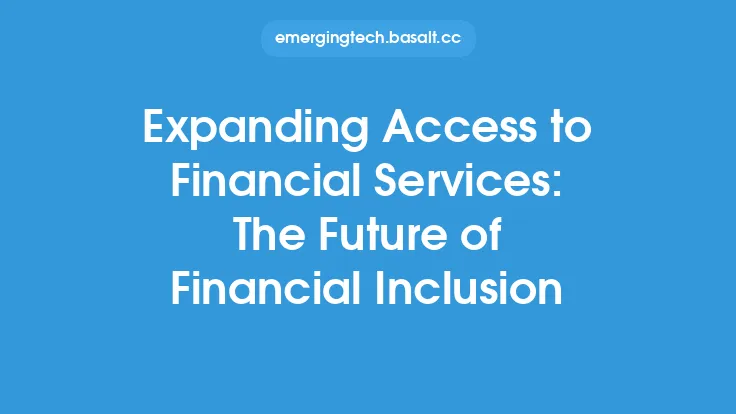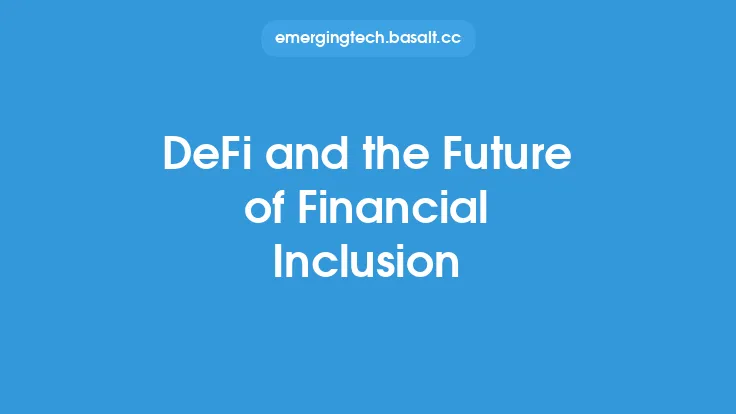Financial inclusion is a crucial aspect of economic development, as it enables individuals and businesses to access financial services, manage their finances effectively, and participate in the formal economy. The lack of access to financial services can hinder economic growth, perpetuate poverty, and limit opportunities for economic mobility. In this article, we will explore the role of financial inclusion in economic growth, its benefits, and the various initiatives and technologies that can help promote financial inclusion.
Introduction to Financial Inclusion
Financial inclusion refers to the availability and accessibility of financial services, such as banking, credit, insurance, and payments, to all segments of society, particularly the underserved and marginalized populations. It involves providing affordable, convenient, and secure financial services to individuals and businesses, regardless of their income level, geographic location, or social status. Financial inclusion is essential for promoting economic growth, reducing poverty, and improving living standards.
Benefits of Financial Inclusion
Financial inclusion has numerous benefits for individuals, businesses, and the economy as a whole. Some of the key benefits include:
- Increased access to credit: Financial inclusion enables individuals and businesses to access credit, which can be used to invest in education, healthcare, and entrepreneurial activities.
- Improved financial management: Financial inclusion provides individuals and businesses with the tools and services needed to manage their finances effectively, reduce debt, and build savings.
- Enhanced economic opportunities: Financial inclusion can help individuals and businesses to participate in the formal economy, access new markets, and increase their economic opportunities.
- Reduced poverty: Financial inclusion can help reduce poverty by providing access to financial services, such as microfinance, that can help individuals and businesses to invest in income-generating activities.
- Increased economic growth: Financial inclusion can contribute to economic growth by increasing access to financial services, promoting entrepreneurship, and improving financial management.
Initiatives to Promote Financial Inclusion
There are several initiatives and technologies that can help promote financial inclusion, including:
- Mobile banking: Mobile banking has revolutionized the way people access financial services, particularly in developing countries where traditional banking infrastructure is limited.
- Digital payments: Digital payments, such as mobile money and online payment systems, have made it easier for individuals and businesses to make transactions and access financial services.
- Microfinance: Microfinance institutions provide small loans and other financial services to individuals and businesses that do not have access to traditional banking services.
- Financial literacy programs: Financial literacy programs can help individuals and businesses to understand financial concepts, manage their finances effectively, and make informed financial decisions.
- Regulatory reforms: Regulatory reforms, such as reducing barriers to entry and improving regulatory frameworks, can help to promote financial inclusion by encouraging innovation and competition in the financial sector.
Technologies that Support Financial Inclusion
Several technologies can support financial inclusion, including:
- Blockchain: Blockchain technology can help to promote financial inclusion by providing a secure, transparent, and efficient way to conduct transactions and access financial services.
- Artificial intelligence: Artificial intelligence can help to promote financial inclusion by providing personalized financial services, improving credit scoring, and reducing the cost of financial services.
- Big data: Big data can help to promote financial inclusion by providing insights into customer behavior, improving risk management, and reducing the cost of financial services.
- Mobile technology: Mobile technology can help to promote financial inclusion by providing access to financial services, improving financial literacy, and reducing the cost of financial services.
Challenges to Financial Inclusion
Despite the benefits and initiatives to promote financial inclusion, there are several challenges that need to be addressed, including:
- Lack of infrastructure: In many developing countries, the lack of infrastructure, such as roads, electricity, and internet connectivity, can hinder access to financial services.
- Regulatory barriers: Regulatory barriers, such as strict licensing requirements and high capital requirements, can limit the ability of financial institutions to provide services to underserved populations.
- Limited financial literacy: Limited financial literacy can make it difficult for individuals and businesses to understand financial concepts, manage their finances effectively, and make informed financial decisions.
- High costs: High costs, such as transaction fees and interest rates, can make financial services unaffordable for many individuals and businesses.
Conclusion
Financial inclusion is a critical component of economic development, as it enables individuals and businesses to access financial services, manage their finances effectively, and participate in the formal economy. While there are several benefits and initiatives to promote financial inclusion, there are also challenges that need to be addressed. By leveraging technologies, such as mobile banking, digital payments, and blockchain, and implementing regulatory reforms, financial literacy programs, and initiatives to reduce costs and improve infrastructure, we can promote financial inclusion and contribute to economic growth, reduce poverty, and improve living standards.





